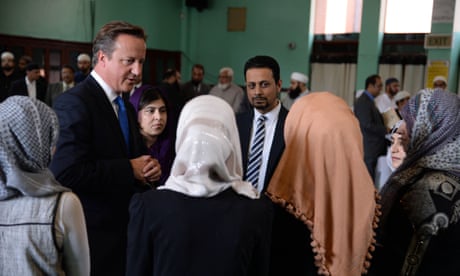Muslim women are the most economically disadvantaged group in Britain. They are three times more likely than other women to be unemployed or looking for work, and twice as likely to be economically inactive (ie, not looking for work). Those who have the same educational qualifications and skills as white Christian women are 71% more likely to be jobless.

Cameron 'stigmatising Muslim women' with English language policy
These bleak findings appear in an MPs’ report published today. This is bad news for Muslims, feminists, anti-racists and for the nation. Britain cannot be highly productive, functional, inventive, internationally competitive or properly meritocratic while so much human potential remains dormant or suppressed. Families and communities with unemployed women cannot escape poverty and hopelessness. So why is this happening?
British Muslim women have come a long way since the 1980s. In 1984 the study Black and White Britain was published by the Policy Studies Institute. The author, Colin Brown, is now my husband. He found that though vastly fewer Asian women than black or white women were in the workforce, among those Asian women in employment only 18% were Muslim. Today eight Muslim women are in parliament, and several are peers. More British Muslim women than men are getting degrees.
I am a part-time professor at Middlesex University, where many of my students are feisty young Muslim women. One of them, Saira (not her real name), told me recently: “My mother can’t read or write. They got her married at 12, when she was a child. But she pushed me and my five sisters, stopped my father arranging our marriages. She is like a lioness.” Sharmin was a young, incredibly bright Bangladeshi mum in Bethnal Green. I used to teach her English. After her husband left her and married a younger wife, she enrolled at a further education college. She is now a social worker.
Some Muslim leaders have been calling for these transformative developments for a very long time. Back in 1924, our worldwide imam, the Aga Khan, instructed his believers to educate daughters because they would then go on to raise educated children and, in time, prepare congregations for a future they could not even imagine. As a child in the 60s, I remember the first time I saw women doctors in our mosque surgery in Kampala, Uganda, and teachers clip-clopping in high heels in our schools.
According to the parliamentary report, “the impact of Islamophobia cannot be underestimated” and there is now a “chill factor” stopping women applying for jobs and promotion. What a blow that must be. All that faith, all that education, for what turns out to be a false promise, a chimera. They face a triple penalty: they are female, of minority background and Muslim.
One recommendation in the report is name-blind recruitment. This would help, but not that much. Women who sound “British” and believe they are, turn up at interviews where visceral hostility comes at them. I have experienced it several times in my own life. I started to apply with just “Brown” as my surname, but then felt the air freeze when I arrived at the interview.
Despite these barriers, 45% more Muslim women are in work than were in 2011. That is a remarkable figure. Yet just when things were getting better, they got worse. Attitudes towards migrants, minorities and refugees have noticeably hardened since Ukip and other rightwing politicians moved from the fringes to the heart of British politics.
Jihadi terror cells undeniably have some support from British Muslims. Muslim self-segregation is also an evident and serious issue. So too Pakistani grooming gangs, whose heinous activities were kept hidden for too long. Needless to say, this is not what most Muslims do or approve of. But these behaviours play into the narratives of racists and have also turned fair-minded people against Islam and Muslims.
The most “integrated” of us are insulted, abused or attacked. Muslims can’t fly, walk, talk, or use public transport or public spaces without fear of being seen as a terrorist. Since the late 60s, when the first race relations laws were passed, most white Brits accepted the need to protect minorities against discrimination. Not any more, it seems. TheCommission for Racial Equality was abolished a decade ago and its notional replacement, the Equality and Human Rights Commission, is moribund. Race equality has been kicked off the agenda while racism goes up.
However, the report’s authors are completely right when they say the discrimination Muslim women experience “is exacerbated by the pressures that some women feel from parts of their communities to fulfil a more traditional role”. It’s clear that self-segregation is increasing within some communities.Farhat Hashmi, who gained her PhD from Glasgow University, is one of the most influential internet female proselytisers. She orders middle-class women to stay at home and give in to men’s demands.
I receive countless letters from young women. They and my acquaintances tell about oppressive practices now being imposed by their brothers, not their fathers.
Yasmin Weaver of the gender equality group Inspire says that addressing unemployment among Muslims is a priority for government and must be a priority for Muslim communities too. This, I fear, is where we fall flat. Weaver believes strongly that anti-discrimination measures need to go hand in hand with a reform of cultural, parental and religious practices and beliefs.
The parliamentary report recognises that both discrimination and internal oppression keep Muslim women in their airless, hopeless places. Governments can tackle the first, but who in a liberal society would dare challenge the second?



